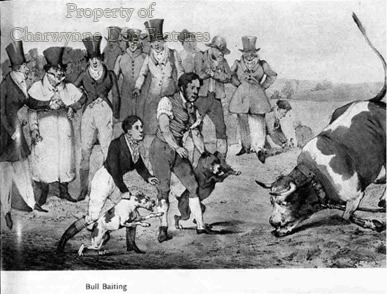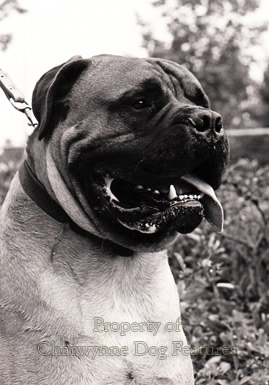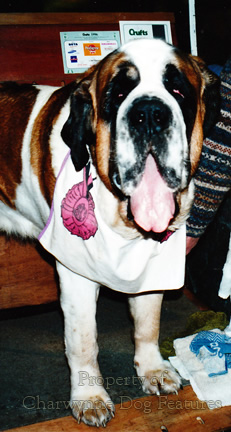932 THE WAY WE WERE
THE WAY WE WERE
by David Hancock

 An exaggeration, writer Kahlil Gilbran once claimed, is a truth that has lost its temper. Being true to any breed of dog involves respect for the Breed Standard and respect for the dogs of that breed. Exaggerating the physical features of a subject creature, to its subsequent discomfort, to me indicates disrespect both for the breed design and, more importantly, the dogs themselves. Less well-informed members of the public have come to think of exaggerations in some pedigree breeds of dog as being typical, traditional and not affecting the animal's quality of life. Not so. Contemporary breeds like the Bull Terrier, Basset Hound, Bloodhound, Bulldog, Dachshund and St Bernard are now quite unlike their own ancestors; they defy their own breed heritage and mock their distinguished lineage. Each of these breeds has been knowingly deformed by man.
An exaggeration, writer Kahlil Gilbran once claimed, is a truth that has lost its temper. Being true to any breed of dog involves respect for the Breed Standard and respect for the dogs of that breed. Exaggerating the physical features of a subject creature, to its subsequent discomfort, to me indicates disrespect both for the breed design and, more importantly, the dogs themselves. Less well-informed members of the public have come to think of exaggerations in some pedigree breeds of dog as being typical, traditional and not affecting the animal's quality of life. Not so. Contemporary breeds like the Bull Terrier, Basset Hound, Bloodhound, Bulldog, Dachshund and St Bernard are now quite unlike their own ancestors; they defy their own breed heritage and mock their distinguished lineage. Each of these breeds has been knowingly deformed by man.
The words of Robert Frost: "Most of the change we think we see in life, Is due to truths being in and out of favour... " could so easily describe the relationship between show-dog breeders and exhibitors and the wording of the Kennel Club standards laid down as the blueprint for each recognised breed. Ignoring the true meaning or the intentional misreading of the written design criteria for any breed is a form of indirect wickedness; such an act suits the humans involved but rarely the dog. But can any genuine dog lover truly want to produce a Bulldog and a Pug that cannot breathe, an Old English Sheepdog and a Beardie that cannot see and a Bloodhound or a Neapolitan Mastiff that not only drools saliva over every item within range but has discomfort from sunken eyes and an over-abundance of loose skin? Can any breeder producing a Basset Hound or a Cocker Spaniel that steps on its own ears and has chronic eye problems claim to love the breed? 
Broad-mouthed "holding" dogs like the mastiff breeds predate the much-mentioned, falsely-associated Molossian dogs; they were valued by Assyrians, Scythians and the Sarmatians as heavy hounds over two thousand years ago. The Bullmastiff as a breed-type existed long before SE Moseley stabilised the modern breed from his Farcroft kennels. The Mas tiff of England was much more like a heavy hound before the advent of pedigree dog shows. The Bulldogs of the baiting contests were much more like Staffordshire Bull Terriers than the modern pedigree show Bulldog. And if you look at portrayals of the prototypal Bullmastiffs and consult the official Kennel Club Breed Standard, you are struck at once by the incorrect skull conformation in so many specimens in the breed today. The breed must have a muzzle!
tiff of England was much more like a heavy hound before the advent of pedigree dog shows. The Bulldogs of the baiting contests were much more like Staffordshire Bull Terriers than the modern pedigree show Bulldog. And if you look at portrayals of the prototypal Bullmastiffs and consult the official Kennel Club Breed Standard, you are struck at once by the incorrect skull conformation in so many specimens in the breed today. The breed must have a muzzle!
The extant Breed Standard, authorised by the Kennel Club, makes this stipulation on the muzzle of the Bullmastiff: ..."distance from tip of nose to stop approximately one third of length from tip of nose to centre of occiput..." If you look at photographs of early specimens of the breed, e.g.: "Roger of the Fenns", his daughter "Jeanette of Brooklands", "Farcroft Fidelity", "Wisdom of Wynyard", "Pridzor Supreme", "Jeanie of Wynyard" and the great stud "Rhodian", you will see that each one has a well-formed muzzle in keeping with the breed standard. Some forty years ago, great dogs like "Bulstaff Achilles", "Chips of Harbex" and "Ambassador of Buttonoak" still exemplified the required muzzle. True type is timeless!

Yet time and time again in today's show rings I see pug-faced, apple-headed Bullmastiffs exhibited, with hyper-abbreviated muzzles - in clear breach of the Breed blueprint, and they win! And they win at the World Dog Show! The early examples of the breed also had tight mouths. Now we are seeing loose-lipped drooling specimens quite unlike their forebears. It is bad enough when Bulldog, Bloodhound and St Bernard breeders produce such caricatures. But traditionally Bullmastiff breeders have had more sense and kept faith. However unless contemporary Bullmastiff fanciers become responsible, realistic and reverse these tendencies, we are going to end up with giant drooling Pugs - a complete travesty of the breed ideal and an insult to those distinguished pioneers who handed on the custody of this superb breed of dog for us to protect in our lifetime.
The slobbering, loose-lipped, muzzle-less sample of the modern Bullmastiff is, in reality, a huge Bulldog, not a Bullmastiff at all. If you dispute this, look at examples of the American Bulldogs, weighing 120lbs, now being imported from the United States in increasing numbers at the present time. The shared ancestry with the Bulldog is acknowledged by Bullmastiff fanciers but the essential type so precious in the breed is being put at risk. Without the correct muzzle length, the true Bullmastiff breed type cannot be achieved. Some of these huge Bulldogs masquerading as Bullmastiffs are magnificent dogs, deserving of our admiration - but they are not Bullmastiffs. Heavily-dewlapped, grotesquely loose-lipped, saliva-slobbering Bullmastiffs are in effect "English Neapolitan Mastiffs" rather than the genuine article. It is important for these two fine breeds of broad-mouthed dogs to retain their separate identities. The sad fact is however that if you allow small exaggerations into a breed then those small exaggerations soon exaggerate themselves. And with a closed gene pool the exaggerations get more pronounced with each generation.
The working Basset Hound fraternity has outcrossed to the Harrier to remedy the problem of exaggerations exaggerating themselves in that breed. Edwin Brough, the greatly-respected pioneer-breeder of pedigree Bloodhounds, recommended an outcross every fifth generation to retain virility and type. An outcross to the big black and tan Dumfriesshire Foxhound was used some fifty years ago. Now an outcross to one of the packs of hunting bloodhounds is being mooted. The St Bernard in today's show rings is revealing far too much of the Mastiff blood utilised by breeders a century ago and is not only quite unlike its own hospice ancestors but markedly different from its native companion breeds, also bred to operate in the high pastures, the Bernese Mountain Dog, the Greater Swiss Mountain Dog, the Appenzeller and the Entlebucher. The pursuit of 'great bone' and great size in the breed to the detriment of soundness, strength and virility, has not been wise. Neither has the imposition of a rugger-ball for a head in the Bull Terrier, in pursuit of the dreaded 'downface', nor the strange desire to make the lovable Basset Hound more like the cartoon character in a national newspaper than is good for a living creature.
Dog breeders have a huge moral responsibility, magnified by the increasing loss of role for breeds which once worked. Function once decided design; now the whim of man all too often distorts a design originally drawn up by knowledgeable people who worked their dogs. Pastoral breeds were never intended to possess coats which would hamper them at work. Working Bloodhounds do not display the degree of wrinkle seen in the breed in the show rings of today. Working Bassets, or English Bassets as they have become known, do not display the elongated ears, over-long backs and under-length legs found in their show-ring counterparts. The pursuit of undesirable and harmful exaggerations in breeds of dog tells you more about the moral short-comings of man than about the faults in individual dogs.
The Kennel Club is looking all the time at the wording of Breed Standards which result for whatever reason in harmful effects in dogs. As the holders of the copyright of the breed standards, the KC has the ultimate responsibility for undesirable words in them. But in the end less honourable people will misuse any wording presented to them; the promotion of 'their' type and their own tendentious interpretation of the standard will be their preference, whatever the regrettable long-term penalties for their breed. It just needs one influential but misguided breeder or a dissident clique to put at risk over one hundred years of devoted work by generations of worthier breed enthusiasts.
It would not be difficult to restore the historically correct head to the Bull Terrier, a more athletic anatomy to our beloved Bulldog, a healthier physique to the appealing Basset Hound or to reduce the excess of skin on the admirable breed of Bloodhound. The dogs suffer in silence. The public usually accept a breed as it's presented to them. A handsome but slab-sided Irish Setter or Pointer is not exposed as a pet to the penalties such a feature would bring to a working dog on a grouse moor. But the ratio of depth of chest to breadth has been shown to be a factor in the incidence of bloat, a dangerous disease. The amount of haw in the eye of a Basset Hound or Bloodhound might not be life-threatening but the considerable discomfort of constantly having foreign bodies irritating the eye-ball is avoidable and surely must therefore be avoided by the custodians of any breed.
The critiques of judges sometimes reveal the failures of breeders when they describe poor movement, inadequate structure or lack of type. But I know of no Breed Council which sits down either to review judges' comments or consider the state of their particular breed. The dentition in Staffordshire Bull Terriers, the movement in Mastiffs, the structure of Bearded Collies, the too-heavy coats in Rough Collies and the inability of breeds like the Clumber Spaniel, the Scottish Terrier and the Bulldog to give birth naturally would all receive attention in any humane breed council, truly devoted to the best interests of its breed. As a direct result of breeds being abandoned by their own clubs and councils, enlightened individuals are coming together out of despair and out of a genuine love of their breed. The situation in the breed of Bulldog illustrates this most vividly. Pip Nobes in Australia, Lolly Wilkinson in Canada, Jan Dirk van Ginneke in Holland, David Leavitt in America and Ken Mollett in the UK separately strove to produce a healthier, more athletic and more historically correct version of the Bulldog. Pip Nobes bred an 'Aussie Bulldog' with a smaller head and chest, broader hips and a longer muzzle, good news for any Bulldog anywhere.
Ken Mollett formed the Victorian Bulldog Society, composed of a dedicated group of Bulldog lovers with a difference - they prefer healthier Bulldogs and breed them to prove it. In Canada, using stock imported by earlier settlers, Lolly Wilkinson produces athletic and authentic Bulldogs, more like the famous prototypal Bulldogs 'Rosa' and 'Crib' than our show ring specimens allegedly inspired by them. Her dogs live a long time and give birth naturally; ours do not. It is to me shaming that an overseas breeder should have to show our breeders the way to breed the best examples of our most famous native breed of dog.
Change may well depend on the truth being in and out of favour, as Robert Frost declared. Exaggeration may well be, as Gilbran considered, the truth having lost its temper. Change is often needed and welcome; but changes in breeds which are harmful or alter breed type unacceptably are neither needed nor welcome, whether in or out of favour. Harmful exaggerations should make us lose our tempers: with those who inflict needless handicaps on subject creatures. Pedigree dogs are particularly vulnerable, sadly especially in Britain, where we have produced some of the most regrettable exaggerations displayed in the domestic dog. Going back to the breeding of a number of breeds 'the way they were' is neither sentimental nor regressive; it is sorely needed. We have a clear 'duty of care' to every single purebred breed of the domestic dog; we now have to respect it, recast all unsound breeds and start breeding for health, vigour, long-life and, surely, an easing of our consciences!